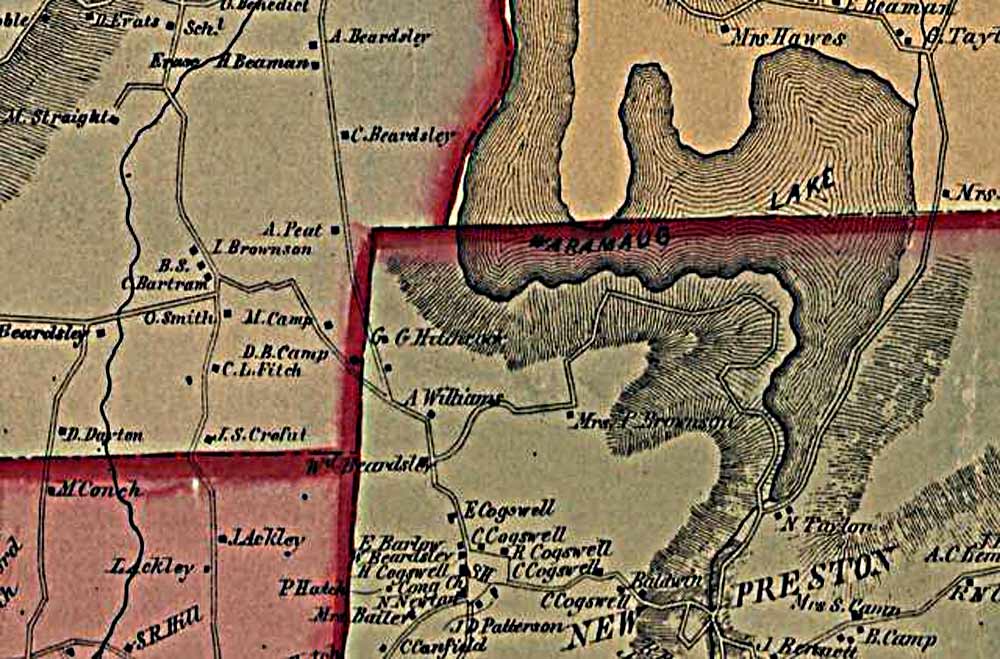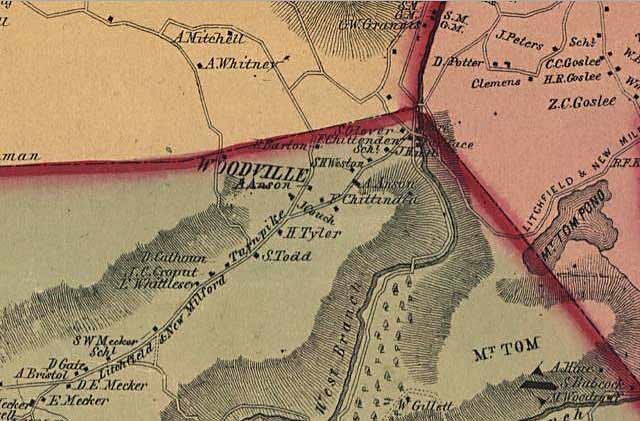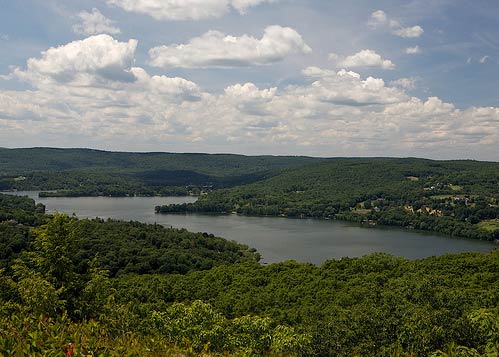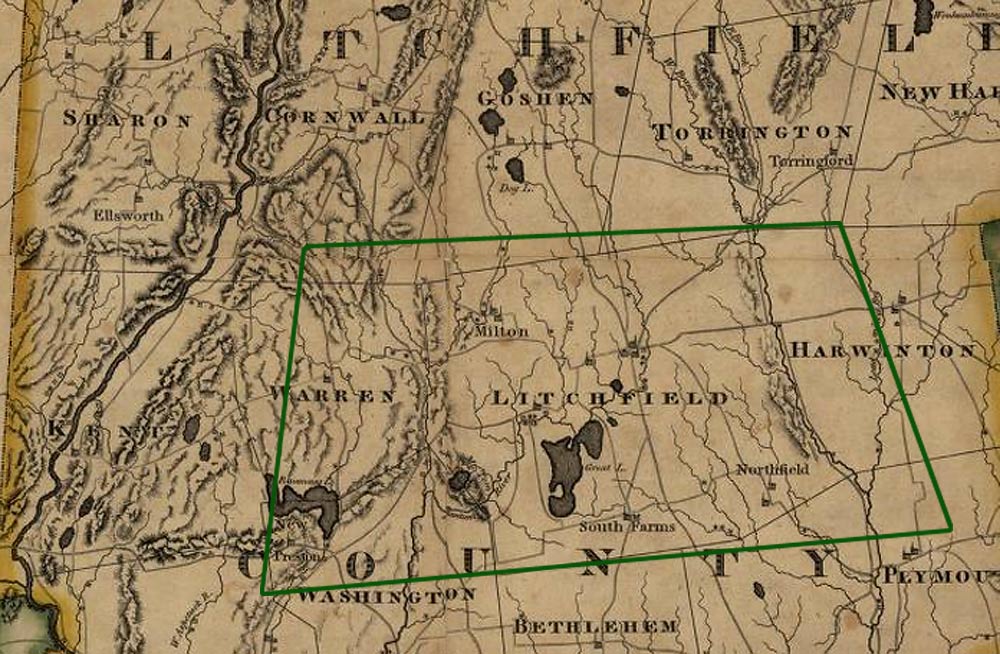Mount Tom and Northrop search
Amos Northrop, came from Milford and purchased 190 acres of land of Job Jonathan Meeker, came from Fairfield in 1743, and purchased, for;£1,30O, 266 |
History of Bethlehem society "east part of the north purchase-- not divided among proprietors until 1734 remained woodland Among the first proprietors -- from the first society (woodbury) came Reuben and Josiah Avered 1739 allowed to set up minister and school Rev Joseph Bellamy at age 22 Fall of 1740 Mr. Whitefireld preached through country religion was revived 1750 the "nervous fever prevailed and spread== not enough wel l to take care of the sick and - a mortal distemper carried off 30 persons in the prime of their life. 1791 Rev Azel Bakus was ordained and settled in Bethlehem.he also "fitted boys for college" teaching latin and greek . later left to become president of hamilton college (1813). 1787 society incorporated into a town Bethlem is a small town, ita average length being four and a half miles, and its breadth four miles. Its population by the census of 1850, was 815. It is almost wholly an agricultural town, its soil being fertile, with little waste land. It has, however, one woolen manufactory, two wagon shops, three saw-mills, one grist-mill, three cider distilleries, one blacksmith's shop, one shoemaker's shop, and three mercantile stores. It also has two churches, a town hall, a flourishing lyceum, two ministers and one physician. -------------- washington The present town of Washington is made up of territory taken from the towns of Woodbury, New Milford, Kent, and Litchfield, and is about six miles square. It contains two ecclesiastical societies, Judea and New Preston, though not the whole of the latter is included within the town. Judea society embraces all the territory taken from Woodbury and Litchfield, and constitutes about two-thirds of the extent of the town. But a small portion of this is contributed by Litchfield. New Preston embraces all the territory taken from Kent and New Milford. In both of these societies are Episcopal churches, having houses for religious worship. The first settlement in the town was made in Judea society, in 1734, the year this society and Bethlehem were divided among the proprietors of Woodbury. Joseph Hurlbut was the first settler, and the first framed house was built in 1736. The next settlers after Hurlbut were Increase Moseley, Nathaniel Durkee, John Baker, Friend Weeks, Joseph Gillett and Samuel Pitcher. The first sermon preached in the society was by Isaac Baldwin, of Litchfield, who afterward relinquished his profession, and became the first clerk of the county court for Litchfield county Five years later, the inhabitants had become more numerous, and twenty persons preferred a memorial to the General Assembly, at its May session, 1739, representing that they lived " full eight miles from the Meeting House," and that their wives and children had " to . tarry at home from the worship of God about half of the year," and therefore they pray for " liberty to have preaching six months in the winter," and to be released from paying taxes for a new school-house just built in the first society, and also from parish taxes, that they may build a school-house of their own. The privilege asked for was granted, to continue two years, and they were released from one-half of the parish taxes, and from taxes to build a new meeting-house, provided they were " in no ways Active in the Affair of Building a new Meeting House in said first Society."1 At the October session, 1741, twenty-six individuals petitioned to be incorporated into an ecclesiastical society, and appointed " Our Trusty and well-beloved friend, Friend Weeks, agent and attorney to prosecute our Petition." The petition was signed by Nathaniel Durkee, John Baker, Joseph Gillett, Joseph Chittenden, Elisha Stone, Samuel Pitcher, Jr., James Pitcher, Increase Moseley, Lemuel Baker, Daniel Castle, Samuel Branton, Ezra Terrill, Jr., Ebenezer Allen, Zadock Clark, Elijah Hurd, Joseph Hurd, Joseph Hurlbut, Benjamin Ingraham, Jr., Robert Durkee, Samuel Bell, Jonah Titus, Benjamin Ingraham, John Royce, John Hurd, Jr., Jedediah Hurd, Benjamin Hinman till the troubles arose which involved the country in the war of the Revolution. The unhappy divisions in this society then arose to a high pitch. Almost the entire people became dissatisfied with their minister, though no heresy nor scandal was alleged against him. This contention finally ceased, after which Mr. Brinsmads was much respected till his death, December, 1795, Rev. Ebenezer Porter came here and preached the greater part of the time till his ordination Sept. 7, 1796 Dr. Porter was dismissed from his pastoral charge, Dec. 18,1811, having been elected Professor of Andover Theological Seminary.-not far from the so-called ' Athens of America." In 1753, a putrid fever prevailed in this society, of which twenty or thirty died in six months. In 1776, the dysentery prevailed with great mortality. About thirty persons were swept away by it to the grave. During the preceding year, not a single death occurred, and for the last twenty years preceding 1812, the average mortality in the society was but about one per cent, of the population per annum. During the first seventy years after the establishment of the church, the people of Judea were uniformly prosperous and happy. They were never divided—never split into sects—but deservedly acquired the reputation of being industrious, orderly and harmonious, with but one exception. The exception alluded to, was during the last ten years of Mr. Brinsmade's ministrations, from 1774 to 1784. This was a contention concerning the half-way covenant system, and it is worthy of notice, that during this whole period of ten years, but three members were added to the church. Thus do contentions, even for just causes, ever diminish the prosperity of the church. There have been several revivals, by which considerable numbers were added to the church, as follows: fifty-four in 1804; twenty in 1816; fifty-eight in 1821 ; twenty-nine in 1825; twenty-two in 1827 ; and one hundred and thirty-one in 1831. n October, 1748, eleven persons dwelling in the south-eastern part of Kent, and nine living in the north-eastern part of New Milford, petitioned the General Assembly for liberty to hire a minister six months in the year, on the ground of their living " from seven to ten miles from their places of worship in New Milford and Kent." This request was granted, to continue four years, with exemption from parish rates. Before the end of the four years, in May, 1752, forty- one individuals petitioned for a new ecclesiastical society. Their names were Samuel Averill, Caleb Rude, Samuel Lake, Moses Averill, Henry Davis, Jehiel Murray, Isaac Averill, Joseph Carey, John Guthrie, Daniel Averill, Zebulon Palmer, Jacob Kinne, Samuel Cogswell, Thomas Hodgship, Thos. Morris, Benj. Darling, Samuel Waller, Nathaniel Deuine, Enoch Whjttlesey, Joseph Jons, Stephen Bosworth, Thomas Beeman, John Benedict, Stephen Noble, Gilead Sperry, Elnathan Curtis, John Bostwick, Benajah Bostwick, Matthew Beale, John Cogswell, Zephaniah Branch, Edward Cogswell, Emerson Cogswell, Josiah Cogswell, James Terrill, Joseph Miles, Nathan Hawley, Samuel Cogswell, John Cobb, Benjamin Capuen. At the same session, sixteen persons of East Greenwich, (now Warren,) remonstrated against the incorporation of a new society, stating that their society had lost " thirty-five rateable persons, and £1467 on their list," and that they therefore protest against having any part of their society cut off, as no families can be spared. Kent, at the same time, passed a vote, that this statement was true. New Milford also sent a committee to oppose the application, and it failed. In October, 1753, thirty-nine persons "in the Northern part of New Milford, and the South and South East part of Kent, and a place Called Merry-all," renewed the application for an ecclesiastical society, which was granted, and the society called New Preston, with the following boundaries : " Beginning at the South east corner of New Milford North Purchase, then tunning Southwardly joining upon Woodbury line one mile, from thence running a West line to ye part of the Long Mountain, South West of Capt. Bastwick's farm, then a Northline to the place called the Rockhorse Cobble, and so that course to Merryall line, and then across Merryall to Kent line, and then Running East to the South West corner of James Lake's farm North Easterly to the North West corner of John Henderson's farm, that he now lives on, then running East to East Greenwich line, then running South to y« South West corner of East Greenwich line to Sheppauge river, then running Southwardly upon s<l river to Woodbury Ijne, then running Westwardly on Woodbury line to y« first mentioned bounds," <kc. The first meeting of the society was held at the house of Jacob Kinne, Nov. 23, 1753. The officers chosen were Benajah Bostwick, Clerk, and Samuel "Waller, Stephen Noble and Joseph Gary, Society's Committee. A vote was then passed to " meet at Jacob Kinne's house for 3 months for public AVorship in the winter season," provided they could obtain a minister. John Bostwick, Samuel Waller and Samuel Averill, were appointed a committee to hire a minister for three months. On the first Monday in December following, the society laid a tax of 12rf. on the pound, to hire a minister " for a season." They also voted to build by subscription, " two school-houses for the use of the society, one to be located between Nathaniel Bostwick's house and Steep Brook, in ye Highway, and the other near Joseph Gary's in the Highway." The following vote also passed : There have been several revivals, which added considerable numbers to the church : thirty in 1780 ; twenty-five in 1804 ; thirteen in 1812 ; eighty in 1816 ; forty-one in 1821; thirteen in 1826 ; thirty- eight in 1827 ; and thirteen in 1829. Washington, composed of the two societies of Judea and New Preston, was the first town incorporated in the state, after the declaration of independence. It was incorporated at a special session of the General Assembly, January 7,1779. The petitioners, who numbered forty-seven in Kent, one hundred and seventy-six in Woodbury, twenty in Litchfield, and twenty in New Milford, desired the Assembly to call their town by the name of Hampden, but their agents were persuaded to consent to have it called Washington, in honor of the commander-in-chief of the American armies. Its first meeting was held February 11, 1779, and William Cogswell was the first moderator. Its boundaries are as follows: " Beginning at the south-west corner of Judea parish; thence running a straight line easterly, to the south-west corner of Bethlehem, five miles and about one quarter of a mile; thence North by Bethlehem to Litchfield line, it being the north-west corner of Bethlehem ; thence continuing north in a straight line, to the north-east corner of the tract annexed from Litchfield; (the east line of Washington, so far as it is straight, is between five and six miles;) thence in a north-westerly direction, across the western part of Mount Tom, to Mount Tom bridge, crossing the western branch of Sheppauge river : thence in a line westerly, between Washington and Warren, to the West Pond; thence across said pond ninety rods to Fairweather's Grant. The diagonal line from the northeast corner of Washington to Mount Tom bridge, is about two miles and an half: the north line is about five miles in length. From the northwest corner of Washington the line runs about South, between Washington and Kent, one mile and a half to New Milford line; thence still South to the South line of New Milford, north purchase ; thence Southerly to the South-east bounds of the parish of New Preston, about one mile and an half; thence by New Milford, about three miles and an half to the first mentioned bounds." Washngton This is a good agricultural town, and has a considerable manufacturing interest. There are within its limits, six mercantile stores, employing a capital of from $12,000 to $15,000 ; one woolen manufactory, employing a capital of some $10,000, and making from 70,000 to 80,000 yards of cloth annually. There are two forges, not now in operation, and one cotton manufactory. There are two pocket furnaces with machine shops attached, employing from twelve to twenty men each, four wagon shops, one saddler's shop, one tannery, one chair and cabinet shop, one manufactory for making carpet yarn and seine twine, and fourteen saw-mills. From 600 to 1,000 casks of lime are annually burned, and from 25,000 to 30,000 feet of marble per annum, are quarried and sawed. There are three Congregational churches, and two Episcopal; a celebrated female seminary, under the care of Miss Brinsmade, and a select school for boys, under the care of Frederick W. Gunn, A. B. There is also a good circulating library. The population of the town, by the census of 1850, is 1,802. In 1708, an act of toleration passed, allowing all persons who should conform to it, the liberty of worshiping God in a way separate from that established by law, but it did not excuse them from paying taxes to the approved, settled ministers of the churches. In 1727, the members of the church of England made an application to the legislature to be exempted from paying taxes for the support 'of the ministry of any other denomination, and for liberty to tax themselves for the support of their own ministry. Accordingly an act was passed, directing that all persons within the limits of a parish, belonging to the church of England, and to the churches established by law, should be taxed by the same rule, and in the same proportion, for the support of the ministry in such parish, and where there was a society of the church of England, so near to any person who had declared himself to be of that church, that he could conveniently and did ordinarily attend public worship there, then the collector of the tax, on levying the same, should pay it to that minister of the church of England on which such person attended, who should have power to receive and recover the same ; and when the amount so obtained should be insufficient for the support of any such minister, the members of the society were vested with the power of taxing themselves, and they were also exempted from paying taxes for building or repairing the meeting-houses of the established churches. The same privileges were afterward granted to other dissenters from the established faith. In the revision of 1784, all dissenters were exempted from paying taxes to the established societies, where they had a society of their own and contributed to its support, on lodging a certificate from such church or society, properly authenticated, of the fact of such membership. Some disputes having arisen as to the validity of such certificates, and suspicions arising that an undue advantage was taken of the law, an act was passed, May, 1791, directing that certificates to be valid, must be approved by a justice of the peace. This law excited general disapprobation, and in October, the same year, an act was passed, authorizing dissenters to make certificates in their own names, and lodge them with the clerk of the society, in the limits of which they lived, which should exempt them from taxes as long as they ordinarily attended public worship in the society which they joined, and dissenting societies were authorized to tax themselves for all the purposes of other ecclesiastical societies. This was in effect placing all religious denominations on the same footing. Yet there was a nominal distinction, members of one society being obliged to lodge certificates with another. But now by the constitution, all distinction among societies is done away, and all denominations are placed on equal ground. History of ancient Woodbury, Connecticut By William Cothren |
Perhaps the Northrops stayed in the same area from the earliest census. I thought perhaps it was the Woodville section from names on some of the maps (NE of Washington by Mt. Tom), but perhaps they were in the corner where Kent, Warren and Washington meet.

1859 Hopkins Map Litchfield County
| Kent | Warren |
| Washington |

Woodville Section of Washington by Mount Tom
| Warren | Litchfield |
| Washington |
West of Litchfield. Warren, formerly a part of Kent, was settled about 1737. The parish of East Greenwich was organized in 1750. In 1786, a town was incorporated and named for a Massachusetts man, Gen. Joseph Warren, the Revolutionary hero, who lost his life at Bunker Hill. The town consists of a high plateau, bordered on the south by Lake Waramaug.
Lake Waramaug
![]()

![]() New Preston, Connecticut. From the top of the "hill" that's just southeast of Lake Waramaug called The Pinnacle.
New Preston, Connecticut. From the top of the "hill" that's just southeast of Lake Waramaug called The Pinnacle.
above from http://www.flickr.com/photos/richardspics/718893025/in/pool-24554386@N00
THE tract now comprising the towns of Kent and Warren was sold at auction at the court house in Windham, in March, 1738. The settlernent commenced the same year.The principal settlers were from Colchester, Fairfield and Norwalk The first minister was the Rev. Cyrus Marsh, ordained in May, 1741.

